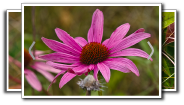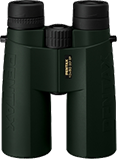cutleaf teasel
(Dipsacus laciniatus)
Conservation • Weed • Wetland • Description • Habitat • Ecology • Use • Distribution • Taxonomy
Description |
Cutleaf teasel is an exotic, tall, herbaceous forb. It is native to Europe and Asia. It is believed to have been introduced into North America in the 1700s. It was cultivated as a garden ornamental and for use as a tool and as a dye in the fabric industry. It escaped cultivation and is now widely naturalized. It was often planted around cemeteries, where it was used to create wreaths for the recently deceased. Cutleaf teasel is found in open, sunny areas, including prairies, savannas, sedge meadows, pastures, stream banks, roadsides, ditches, fence rows, railroads, and other disturbed sites. It grows under full or partial sun, in moderately moist, loamy soil. Cutleaf teasel forms dense stands that can outcompete native species. Once it becomes established it can be difficult to eradicate. Each plant can produce up to 1,500 or more seeds. The seeds remain viable in the soil for two years or more. When pulled or dug up, any portion of the taproot that remains can regenerate the plant. Cutleaf teasel is an erect, biennial forb that rises from a stout taproot. It can be 1¾′ to 8′ (0.5 to 2.5 m) tall, but it is usually no more than 6′ (1.8 m) tall in Minnesota. In the first year it appears as a rosette of basal leaves. The basal leaves are stalkless or short-stalked, oblong inversely lance-shaped to narrowly egg-shaped, up to 16″ (40 cm) long or longer, and up to 4″ (10 cm) wide. The leaf blades are irregularly pinnately lobed. The lobes are oblong and are usually lobed again. The margins are sometimes bluntly toothed, sometimes prickly, always with a fringe of short hairs (ciliate). The lower leaf surface is prickly along the midvein. Basal leaves are often withered or absent at flowering time. In the second year, usually a single stem is produced. The stems are erect, stout, ridged or angled, branched above the middle, and prickly. Stem leaves are opposite, stalkless, and 1¼″ to 19¾″ (3 to 50 cm) long. The leaf bases are joined around the stem forming a cup-like structure. Lower leaf blades are oblong lance-shaped in outline, usually somewhat folded longitudinally, and irregularly pinnately lobed or twice lobed. They become progressively smaller and less divided as they rise the stem. The uppermost leaved are unlobed or nearly unlobed. The inflorescence is a single, thistle-like, flower head at the tip of the stem and each branch. Each flower head is subtended by one or two whorls of modified leaves (bracts). The bracts are narrowly lance-shaped to linear, flattened in cross section, and widely spreading or curved upwards. They are unequal in length, ⅝″ to 4″ (1.5 to 10 cm) long. The longest is often longer than the flower head. The tip ends with a sharp spine, and the margins and midrib are prickly. The flower head is an egg-shaped to cylindrical, 1¼″ to 4″ (3 to 10 cm) long, 1″ to 2″ (2.5 to 5.0 cm) wide, dense array of up to 1,500 or more small flowers. Each flower is subtended by a single bractlet. The bractlet is abruptly narrowed near the base into an ascending, rigid, spine-like, up to 1″ long awn. Each flower is ½″ to ⅝″ (12 to 15 mm) long. There are 4 outer floral leaves (sepals), 4 petals, 4 stamens, and 1 style. The sepals (collectively the calyx) are fused into a 1⁄32″ to 1⁄16″ (1 to 2 mm) long, cup-like base. The petals are fused at the base into a long tube and divided at the tip into 4 short, rounded lobes. The outer surface is densely minutely hairy. The stamens have slender stalks (filaments) and white anthers, They project beyond the petals. The fruit is a dry, light brown, ⅛″ to 3 ⁄16″ (4 to 5 mm) long, seed capsule (achene) with a single seed. |
Height |
1¾′ to 8′ (0.5 to 2.5 m) |
Flower Color |
White |
Similar Species |
Habitat |
Moderately moist. Prairies, savannas, sedge meadows, pastures, and on stream banks, roadsides, ditches, fence rows, railroads, and other disturbed sites. Full sun. Loamy soil. |
Ecology |
Flowering |
July to September |
Pests and Diseases |
|
Use |
The heads were used to in the fabric industry to raise the nap of cloth during the fulling process. |
Distribution |
||
|
Sources |
|
| 3/1/2025 | ||
Nativity |
||
Native to Europe and Asia. Introduced and naturalized in North America. |
||
Occurrence |
||
|
||
Taxonomy |
|
Kingdom |
|
Division |
Tracheophyta (Vascular Plants) |
Subdivision |
Spermatophytina (Seed Plants) |
Class |
|
Order |
Dipsacales (honeysuckles, moschatels, and allies) |
Family |
Caprifoliaceae (honeysuckle) |
Subfamily |
Dipsacoideae |
Genus |
Dipsacus (teasels) |
Family |
|
Subordinate Taxa |
|
|
|
Synonyms |
|
Dipsacus fullonum Dipsacus fullonum ssp. laciniatus Dipsacus fullonum var. laciniatus Dipsacus laciniatus var. comosus Dipsacus microcephalus Dipsacus sylvestris ssp. laciniatus |
|
Common Names |
|
cutleaf teasel cut-leaf teasel cut-leaved teasel |
|
Glossary
Achene
A dry, one-chambered, single-seeded seed capsule, formed from a single carpel, with the seed attached to the membranous outer layer (wall) only by the seed stalk; the wall, formed entirely from the wall of the superior ovary, does not split open at maturity, but relies on decay or predation to release the contents.
Awn
A stiff, bristle-like appendage at the tip of the glume, lemma, or palea of grass florets.
Bract
Modified leaf at the base of a flower stalk, flower cluster, or inflorescence.
Bractlet
A small, often secondary bract within an inflorescence; a bract that is borne on a petiole instead of subtending it; bracteole.
Calyx
The group of outer floral leaves (sepals) below the petals, occasionally forming a tube. Plural: calyces.
Filament
On plants: The thread-like stalk of a stamen which supports the anther. On Lepidoptera: One of a pair of long, thin, fleshy extensions extending from the thorax, and sometimes also from the abdomen, of a caterpillar.
Pinnate
Having the leaflets of a compound leaf arranged on opposite sides of a common stalk.
Sepal
An outer floral leaf, usually green but sometimes colored, at the base of a flower.
Visitor Photos |
||
Share your photo of this plant. |
||
This button not working for you? |
||
Alfredo Colon |
||
 |
 |
|
MinnesotaSeasons.com Photos |
||
|
||
|
||

Slideshows |
|

Visitor Videos |
||
Share your video of this plant. |
||
This button not working for you? |
||
|
Other Videos |
||
Teasel has its roles in the ecosystem where is native to, an aggressive invasive where is not native |
About
Aug 25, 2024 Teasel - Dipsacus laciniatus is a herbaceous biannual plant, loaded with blooms for pollinators for most of the summer months, its seeds are good bird food, and this plant is not aggressive where is native to. Unfortunately an aggressive invasive in most of North America where it can become the dominant species throughout big stretches of grassland, displacing native plants. |
Cutleaf teasel (Dipsacus laciniatus) - 2024-07-27 |
About
Aug 9, 2024 Dipsacus laciniatus is a species of flowering plant in the honeysuckle family known by the common name cutleaf teasel. It is native to Europe and Asia. It is present in North America as an introduced species and invasive weed. Scientific classification |
The Invasive Scourge of Teasel |
About
Jul 31, 2024 Dipsacus laciniatus is one of the most ubiquitous invasive plants in Chicago and much of the upper Midwest, forming dense thickets along the highways and freeway on-ramps. |

|
Created: 3/3/2025 Last Updated: © MinnesotaSeasons.com. All rights reserved. |


